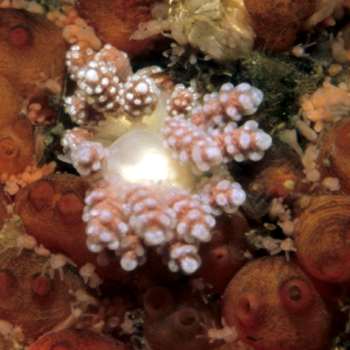
Doto amyra
Marcus, 1961
Order: NUDIBRANCHIA
Suborder: DENDRONOTINA
Family: Dotidae
DISTRIBUTION
West coast of Nth America [Alaska to Baja California, Mexico]
PHOTO
Dodd Narrows, Nanaimo, British Columbia, Canada, Pacific Ocean. Depth: 45 feet. Length: 7 mm. 18 Sept 2005. Current swept channel. Photographer: Marli Wakeling
No dark pigmentation on body which is translucent clear with some white speckling. The major colour feature is the digestive gland which colours the cerata. This ranges in colour from an orange red to a dull cream yellow or pale brown. The ceratal tubercles are elongate and arranged in 3-7 rings. they are often tipped with white. There are between 5 and 7 pairs of cerata.
Reference:
• Marcus, Er. (1961) Part One. Opisthobranch mollusks from California. The Veliger, 3(Supplement): 1-85. (Pls.1-10)
Rudman, W.B., 2002 (April 17) Doto amyra Marcus, 1961. [In] Sea Slug Forum. Australian Museum, Sydney. Available from http://www.seaslugforum.net/find/dotoamyr
Related messages
Re: Doto amyra from British Columbia
August 26, 2009
From: Jackie Hildering & Glen Miller
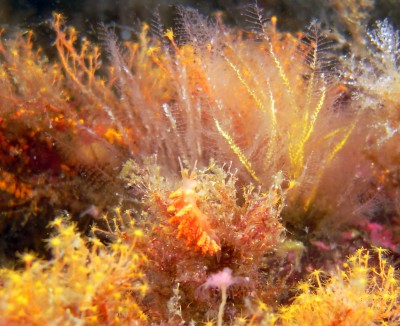
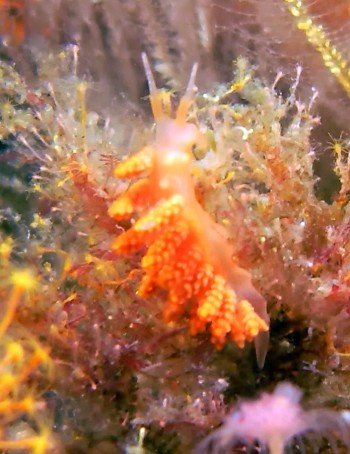
Concerning message #19297:
One of the colour variants of Doto amyra
Locality: NE Pearse, 65 feet, British Columbia, CANADA, Pacific Ocean, 14 June 2009, Wall . Length: +/- 10 mm. Photographer: Jackie Hildering.
Jackie Hildering and Glen Miller
earthlingenterprises@telus.net
Hildering, J. & Miller, G., 2009 (Aug 26) Re: Doto amyra from British Columbia. [Message in] Sea Slug Forum. Australian Museum, Sydney. Available from http://www.seaslugforum.net/find/22552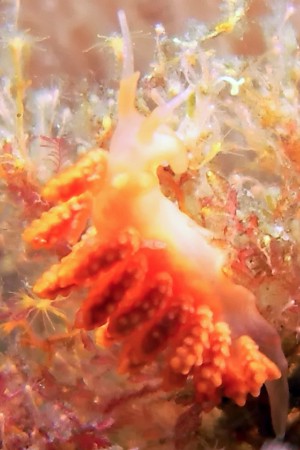
Thanks Jackie and Glen,
Best wishes,
Bill Rudman
Doto amyra from British Columbia
September 11, 2007
From: Clinton Bauder
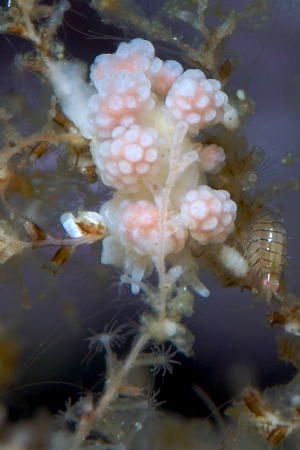
Hi Bill,
More little critters from British Columbia. This is Doto amyra I believe.
Locality: Browning Wall, 18 meters, British Columbia, Canada, Pacific, 27 August 2007, Rock Wall. Length: 1-5 mm. Photographer: Clinton Bauder.
Clinton Bauder
gecko1@apple.com
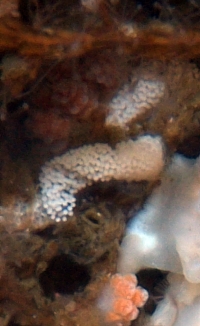
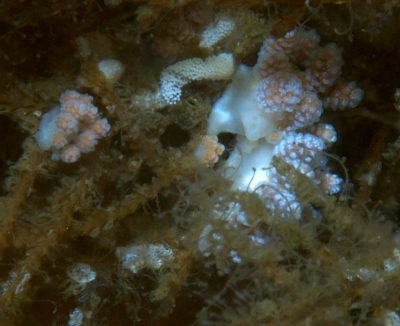
Hi Clinton,
Well you had a heck of a productive trip. This is indeed an archetype D. amyra. They don't get anymore characteristic than this one. Great to document photographically its eggs also.
Thanks again,
Dave Behrens
Re: Doto amyra from La Jolla Shores, California
February 26, 2007
From: Jeff Goddard
Concerning message #19454:
Hi Bill and Dave,
Kevin Lee's Doto from La Jolla is the same as my Doto form A [message #15664 ]. Form A has small eggs and planktotrophic development; these are evident in the egg mass next to the cluster of individuals in Kevin's third photo.
Best wishes,
Jeff
goddard@lifesci.ucsb.edu
Goddard, J.H.R., 2007 (Feb 26) Re: Doto amyra from La Jolla Shores, California. [Message in] Sea Slug Forum. Australian Museum, Sydney. Available from http://www.seaslugforum.net/find/19520Thanks Jeff,
As Bernard Picton suggests in his separate message [#19518] it looks like the west coast Dotos are fertile ground for future research. For example Marli Wakeling's [#19297] large animal seems to have gills on the inside of some of the cerata.
Best wishes,
Bill Rudman
Re: Doto amyra from La Jolla Shores, California
February 26, 2007
From: Bernard Picton
Concerning message #19454:
Hi all,
I think you have actually got several species of Doto here lumped under Doto amyra. Here in the NE Atlantic Lemche showed in 1976 that several species had been lumped under Doto coronata. Since then we have treated these as different species, normally feeding only on a single hydroid. We then find that the appearance of each species is not very variable and it all begins to make sense. As Jeff mentions in his message #15664 there are two development types as well, so that increases the likelihood that they are species rather than colour varieties. (Bear in mind that Pat Krug has now shown that Alderia modesta consists of two species on the Pacific coast, the new one *can* switch developmental modes).
Heike Wagele has done some DNA work on these now and that confirms that the ones she has looked at are species. (Incidentally they are quite distinct 18S sequences compared with other Cladobranchs.) The external and internal differences are subtle, similar to the forms that Jeff Goddard has described. It has been puzzling me that there were not many species known from the north Pacific as generally diversity is higher there than in the north Atlantic. I think you Pacific workers all need to start splitting them into groups on the basis of which hydroid they are eating and start with the assumption that each will be a species. That way if you gather data that shows that one form on a particular hydroid is actually the same (including DNA) as another then you can lump them together later. If you start with a lump you won't gather the evidence correctly to split it.
Bernard Picton
bernard.picton@magni.org.uk
Picton, B. E., 2007 (Feb 26) Re: Doto amyra from La Jolla Shores, California. [Message in] Sea Slug Forum. Australian Museum, Sydney. Available from http://www.seaslugforum.net/find/19518Thanks Bernard,
Bill Rudman
Doto amyra from La Jolla Shores, California
February 22, 2007
From: Kevin Lee
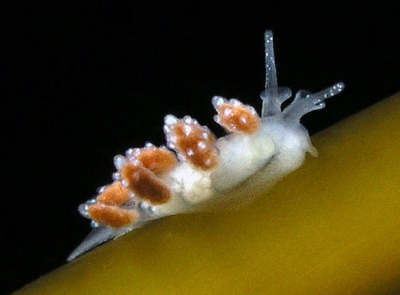
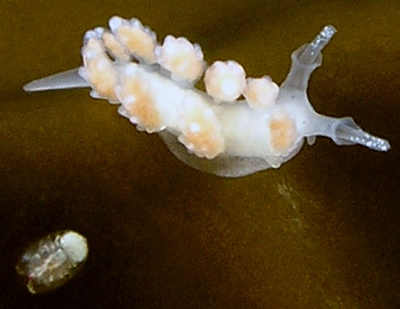
Dear Bill & Dave,
Spurred by reports of Doto sightings, I journeyed south to La Jolla Shores, last weekend. During my first dive, I didn't recognize a single one, perhaps because they are so tiny. On my second dive, I managed to find a few and am pleased to share these photos. Even in extreme macro, the images are not great, I suspect from the limitations of my Oly 5060 camera lens.
Locality: La Jolla Shores, 55~60 feet, California, USA, Eastern Pacific, 10 February 2007, On kelp stems and fronds. Length: 0.25 inch and less. Photographer: Kevin Lee.
Would estimate all animals are 1/4 inch or less. For size comparison, the second frame shows a Doto (with "eye" spots), alongside a copepod. And, in the third frame, a cluster of Dotos mating is shown, but look closely at the upper right corner, where a lone "baby" is hanging out. Nearly microscopic! Hopefully, I am not permanently cross-eyed, as it required extreme concentration to find and photo these minuscule nuds.
K:-)
diverkevin@gmail.com
Lee, K., 2007 (Feb 22) Doto amyra from La Jolla Shores, California. [Message in] Sea Slug Forum. Australian Museum, Sydney. Available from http://www.seaslugforum.net/find/19454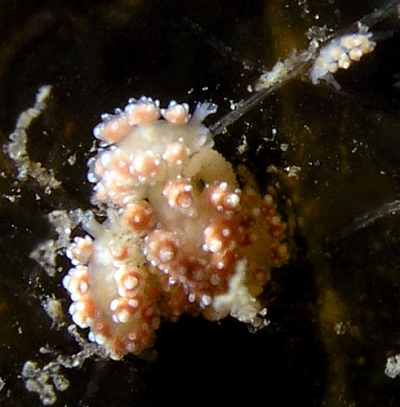
Hi Kevin,
Wow. These may be the best photos of Doto amyra I have ever had the pleasure of seeing. I believe your shots capture all the important characteristics of the type species. Previous messages mention Jeff Goddard's careful review of this variable and complicated species.
Your photos clearly show the characteristic fluted rhinophore with white specks, and the cerata with pinkish cores with rings of white tipped tubercles. Since all of these shots were taken on the same dive they also show the variablity of the ceratal core color.
Thanks for sharing these.
Dave Behrens
Doto amyra from British Columbia
February 8, 2007
From: Marli Wakeling
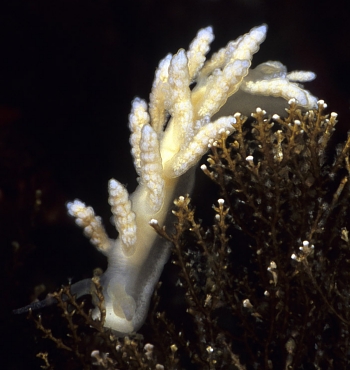
Hi Bill,
Here's the "largest" Doto amyra I have ever encountered. I found it this past summer in a remote area of British Columbia called Seymour Inlet.
Locality: Cotton Channel, Seymour Inlet, 30 feet, British Columbia, Canada, Pacific, 1 September 2006, Boulder covered channel. Length: 15 mm. Photographer: Marli Wakeling.
Cheers,
Marli Wakeling
scubamarli@gmail.com
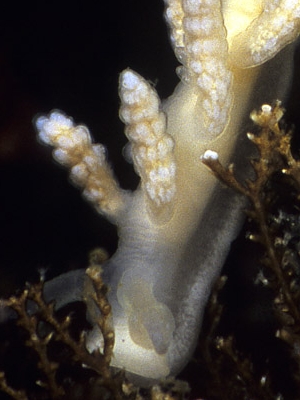
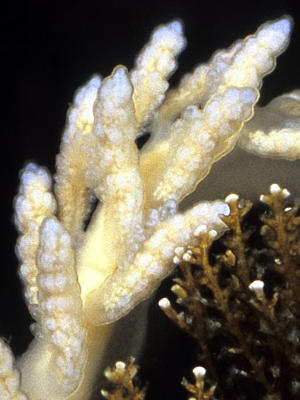
Hi Marli,
Thank you for sharing these great close-ups of Doto amyra. As I am sure you are aware, Jeff Goddard has demonstrated 3 or 4 variants of this little critter. I am not sure I can drop your pure cream colored critter into one of those, but it is definitely D. amyra.
Goddard has shown that the different variants not only occur at different locations along the nominal species geographic range, but feed on different cnidarian prey. I cannot be certain, but the prey your specimen is on looks to me like the hydroid, Grammaria, which occurs in the area you took these photos. Maybe Jeff will reply on his thoughts about this color, and a food prey of Grammaria.
In any event your photos do show some interesting details about the morphology of this genus. With Bill's help cropping tight close-ups you can see the characteristic fluted rhinophores found in the genus. Also noted in the lower right close-up are the knobby, low tubercule covered cerata.
Great stuff. Thanks,
Dave Behrens
Re: Doto cf. columbiana? from British Columbia
January 30, 2006
From: Jeff Goddard
Concerning message #5365:
Hi Bill,
Sorry to bother you with yet another message on a Doto, but I just noticed this older message and photo by Marli Wakeling. The hydroid is a species of Garveia, which both Sandra Millen and I have found Doto amyra feeding on, and when they do, they are orange (Goddard 1996). The identity of both of our slugs was confirmed by the presence of egg masses with relatively large eggs/embryos.
Best wishes,
Jeff
goddard@lifesci.ucsb.edu
Goddard, J.H.R., 2006 (Jan 30) Re: Doto cf. columbiana? from British Columbia. [Message in] Sea Slug Forum. Australian Museum, Sydney. Available from http://www.seaslugforum.net/find/15688Dear Jeff,
It's no bother. It's great to have some of these puzzles sorted out
Best wishes,
Bill Rudman
Doto amyra form A of Goddard (1996)
January 28, 2006
From: Jeff Goddard
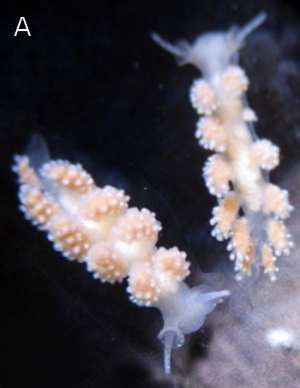
Hi Bill,
Here are two photos [A, B ] of some of the specimens I referred to as Doto form A in my 1996 paper on the development of Doto amyra. These specimens were 7 mm long and were collected from small thecate hydroids under cobbles at the mouth of Drake's Estero, Point Reyes National Seashore in northern California in. Their egg masses produced small planktotrophic larvae with shells averaging 123 microns in length. I have also observed this form and its egg masses under intertidal cobbles at Rincon Point in Santa Barbara County.
Locality: Drake's Estero, Point Reyes National Seashore, California, USA
Pacific coast. Interidal. Length: 7 mm. 24 April 1984. Rocky shore. Photographer: Jeff Goddard
I have also included an image [Photo C] of one of a specimen (4.5 mm long) of Doto and its egg masses in a photograph taken by Hans Bertsch at 60' off of La Jolla, California. Because I didn't examine this specimen directly, I referred conservatively to it in my 1996 paper as a 4th form of Doto that would be identified as Doto amyra as currently understood. The external similarities of this specimen to the specimens of form A from Drake's Estero are obvious, and I consider them to be the same.
These specimens appear to be the same as the specimen referred to as Doto amyra in Behrens (1991), as well as the specimens pictured in Sean Kearney's message [#12493 ].
-
Behrens, D.W. 1991. Pacific Coast Nudibranchs. Sea Challengers, Monterey, California.
-
Goddard, J.H.R. 1996. Lecithotrophic development in Doto amyra (Nudibranchia: Dendronotacea), with a review of developmental mode in the genus. The Veliger 39:43-54.
Best wishes,
Jeff
goddard@lifesci.ucsb.edu
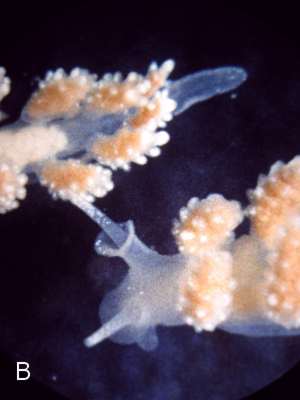
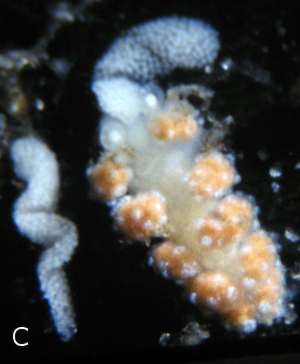
Thanks Jeff,
I'll leave 'Form A' on the Doto amyra page at present. It is obviously impossible at this stage to differentiate the two from photos, but by leaving them together it will draw attention to their differences in reproductive biology
Best wishes,
Bill Rudman
Late embryos of Doto amyra
January 28, 2006
From: Jeff Goddard
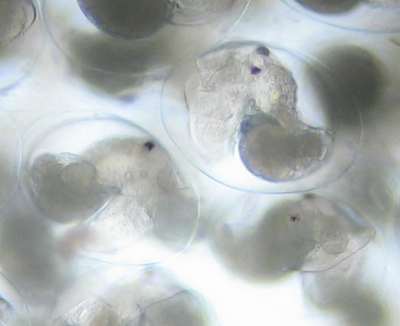
Hi Bill,
Here is a photo of the embryos of Doto amyra close to hatching. The shells average a little over 240 microns in length. The lecithotrophic larvae can swim or crawl and are capable of metamorphosis into a juvenile within a day or two of hatching. Note the eyespots and large foot with a well developed propodium; as described by Bonar (1978, p. 187), the appearance of these structures "signal the approach of metamorphic competence" in opisthobranchs.
Locality: Montana de Oro State Park, California, USA. Pacific coast. Intertidal. Length: 240 microns (shells). May 2005. Rocky shore. Photographer: Jeff Goddard
-
Bonar, D.B. 1978. Morphogenesis at metamorphosis in opisthobranch molluscs. [In] Settlement and metamorphosis of marine invertebrate larvae. Edited by F.S. Chia and M.E. Rice. Elsevier, New York. pp. 177-196.
Best wishes,
Jeff
goddard@lifesci.ucsb.edu
Goddard, J.H.R., 2006 (Jan 28) Late embryos of Doto amyra. [Message in] Sea Slug Forum. Australian Museum, Sydney. Available from http://www.seaslugforum.net/find/15657Thanks Jeff,
Bill Rudman
Doto amyra from Oregon
January 28, 2006
From: Jeff Goddard
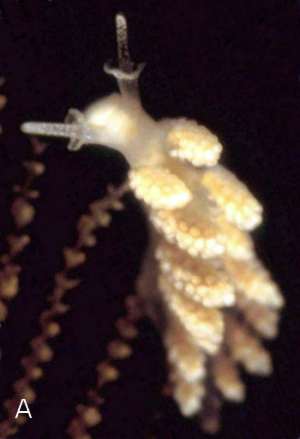
Hi Bill,
Here are some photos of the specimens that laid some of the egg masses on which I based my 1996 paper on lecithotrophic development in Doto amyra.
Locality: Middle Cove, Cape Arago, Oregon, USA. Pacific coast. Intertidal. Length: 12, 7, 11 mm. June 1985 and July 1984. Rocky shore
Photographer: Jeff Goddard
The first two specimens measured 12 mm [A] and 7 [B,D]mm long respectively, and were found on the stolons of thecate hydroid Abietinaria sp. in June 1985. The third specimen was 11 mm long [C] and found at the base of the thecate hydroid Thuiaria sp. in July 1984.
As I mentioned in message [#15639], the body of Doto amyra is light colored and only rarely possesses a light scattering of dark pigment. Its ceratal cores, however, can vary from pale yellow to orange-brown or pink-brown. Doto amyra is usually found hunkered down on the stolons of thecate or athecate hydroids, including Abeitinaria, Sertularia, Aglaophenia, Garveia, and Coryne (Goddard 1996, unpublished observations).
-
Goddard, J.H.R. 1996. Lecithotrophic development in Doto amyra (Nudibranchia: Dendronotacea), with a review of developmental mode in the genus. The Veliger 39: 43-54.
Best wishes,
Jeff
goddard@lifesci.ucsb.edu
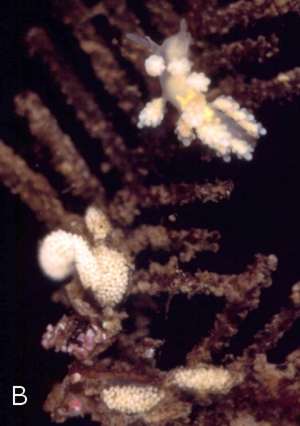
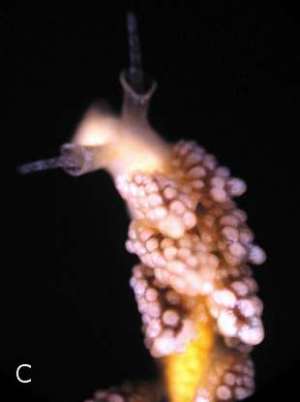
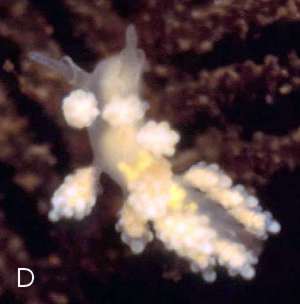
Thanks Jeff,
Bill Rudman
Re: Doto amyra from British Columbia
January 25, 2006
From: Jeff Goddard
Concerning message #13986:
Hi Bill, Dave,
The two specimens of Doto pictured in Marli Wakeling's recent messages [#13986, #13987] both fit what I call Doto amyra, and the same applies to the specimens in her previous messages of [#6487] and [#13717], as well as the 9 August 2004 contribution by Bruce Wight's [#7705 ].
As I reported in my 1996 paper, the body of Doto amyra is light colored and only rarely possesses a light scattering of dark pigment. Its ceratal cores, however, can vary from pale yellow to orange-brown or pink-brown. Moreover, Doto amyra is known to feed on both thecate and athecate hydroids (in the typical Doto manner by rasping through the stolons and stalks and pumping out the enclosed tissues).
By contrast, the three light colored specimens with pink cerata cores in Sean Kearney's message [#12493] do fit what I called Doto form A in my 1996 paper. Their cerata tubercles typically stand out against the bright colored cores, and this form has small planktotrophic larvae (in contrast to the much larger lecithotrophic larvae of Doto amyra). Form A is more common in California, especially southern California, and I have found it only as far north as Coos Bay, Oregon.
I will try to put together for you a set of photos of the forms I referred to in my 1996 paper.
Best wishes,
Jeff
goddard@lifesci.ucsb.edu
Goddard, J.H.R., 2006 (Jan 25) Re: Doto amyra from British Columbia. [Message in] Sea Slug Forum. Australian Museum, Sydney. Available from http://www.seaslugforum.net/find/15639Dear Jeff,
I look forward to some photos
Best wishes,
Bill Rudman
Doto amyra from British Columbia
January 24, 2006
From: Marli Wakeling
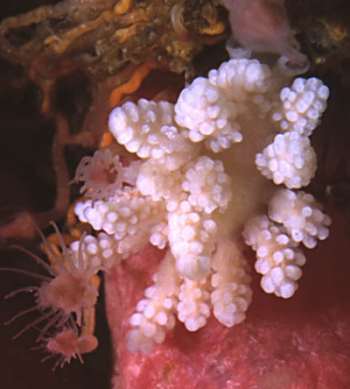
Hi Bill,
Here's a rather large (for a miniscule species), Doto amyra, from Northern Vancouver Island.
Locality: Bob's Spot, Broughton Archipelago, British Columbia, Canada.
Pacific coast. Depth: 45 feet. Length: 10 mm. 22 May 2005. Rocky wall.
Photographer: Marli Wakeling
Cheers,
Marli
scubamarli@excite.com
Wakeling, M., 2006 (Jan 24) Doto amyra from British Columbia. [Message in] Sea Slug Forum. Australian Museum, Sydney. Available from http://www.seaslugforum.net/find/13986Dear Marli,
Making sure identifications of this species is quite difficult, as it has been proposed there may be as many as four distinct species, currently lumped as color variations of Doto amyra.
I would suggest that this is the variation that Jeff Goddard in his 1996 paper discribing the lecithotrophic development of the species, refers to as Form A.
One indication to support this identification is it is feeding on athecate hydroids, and lacks any dark pigmentation.
-
Goddard, J.H.R. 1996. Lecithotrophic development in Doto amyra (Nudibranchia: Dendronotacea), with a review of developmental modes in the genus. The Veliger 39(1):3-54.
Best wishes,
Dave Behrens
Doto amyra? from British Columbia
January 24, 2006
From: Marli Wakeling
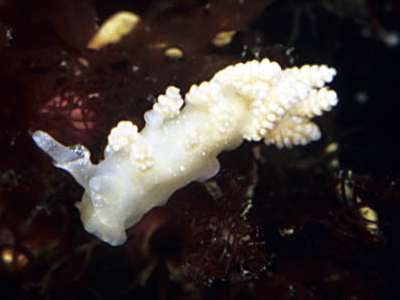
Hi Bill,
Here's what I think is a pale Doto amyra, but the white spots seem a bit different.
Locality: Bob's Spot, Broughton Archipelago, British Columbia, Canada. Pacific. Depth: 40 feet. Length: 5 mm. 22 May 2005. Rocky wall. Photographer: Marli Wakeling
Cheers,
Marli
scubamarli@excite.com
Wakeling, M, 2006 (Jan 24) Doto amyra? from British Columbia. [Message in] Sea Slug Forum. Australian Museum, Sydney. Available from http://www.seaslugforum.net/find/13987Dear Marli,
Yes, as in your previous message [#13986] with a white Doto amyra I would call this Goddard's Form A, of the species
Best wishes,
Dave Behrens
Doto amyra from British Columbia
May 7, 2005
From: Marli Wakeling

Hi Bill,
Here is a Doto amyra from Dodd Narrows, on social tunicates, Pycnoclavella stanleyi, found last fall.
Locality: Dodd Narrows, Nanaimo, British Columbia, Canada, Pacific Ocean. Depth: 45 feet. Length: 7 mm. 18 Sept 2005. Current swept channel
Photographer: Marli Wakeling
Cheers,
Marli Wakeling
scubamarli@excite.com
Wakeling, M., 2005 (May 7) Doto amyra from British Columbia. [Message in] Sea Slug Forum. Australian Museum, Sydney. Available from http://www.seaslugforum.net/find/13717Dear Marli,
It is good to get a photo of this species which unambiguously shows its features. I was surprised to see it on the ascidians but there seem to be hydroids nestling at the base of the all the ascidians. Perhaps they are what it is feeding on.
Best wishes,
Bill Rudman
Doto amyra from California
March 23, 2004
From: Sean Kearney
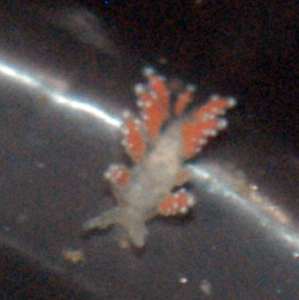
Dear Bill..
I must first apologize for the poor quality of these pictures. These critters were so small that I could not get a decent photo u/w, so I brought them to the surface to try to I.D. them. All were found in 65fsw off of Pt. Loma, San Diego, California. [March 2004]. I noticed the red markings of the Doto amyra, and then saw the lines on the Flabellina? Cuthona?. The Dendronotus? was also in the hydroids nearby.
The Doto kya and the Doto amyra were willing subjects once I got them still and got light on them.
I have sent the the Flabellina? Cuthona? and Dendronotus? 12495 in separate messages.
As always, thanks very much,
Sean Kearney
skearney@dc.rr.com
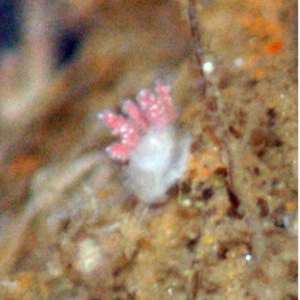
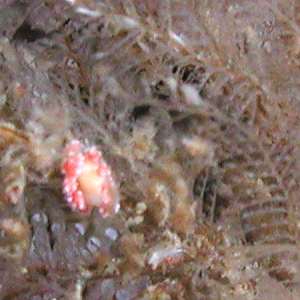
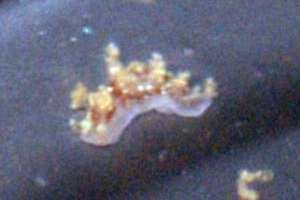
Thanks Sean,
Its nice to get a photo of the pink-red form of Doto amyra. I included your photo of Doto kya alongside. I'm not that familiar with the Californian fauna so I can only tentatively agree with your identification as the photo's a bit fuzzy. These small animals are a bit hard to photograph
Best wishes
Bill
Doto amyra? from San Miguel, California
August 9, 2002
From: Bruce Wight
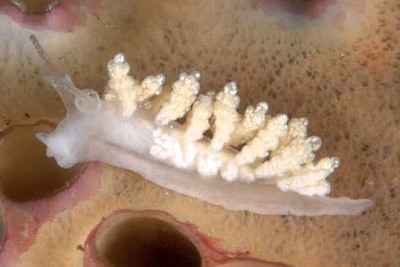
Here is type of Doto I need your help with. It is one of the nudibranchs we saw racently at San Miguel Island, California (July 2002). They were very common on the coralline algae at Wilson's Rock. The lower right photo shows two animals mating.
Thanks,
Bruce Wight
bwproductions@earthlink.net
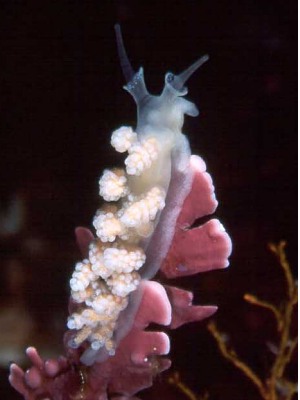
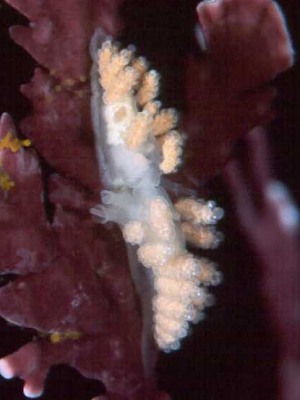
Dear Bruce,
At a guess I would say this is Doto amyra. It is the only Doto from the Nth American west coast I know of that doesn't have any dark pigmentation. I would appreciate confirmation of this identifcation from local experts
Best wishes,
Bill Rudman
Doto amyra from British Columbia
April 19, 2002
From: Marli Wakeling
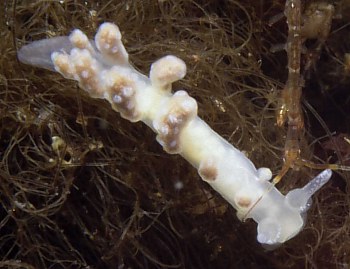
Hi Bill,
I think this is Doto amyra. It was found near Port Hardy, British Columbia, Canada. It is missing cerata, and they are either partly 'bit off' or are regenerating.
PHOTO: Cougar Bay, near Port Hardy, British Columbia, Canada
DEPTH: 35 feet
LENGTH: 8mm
DATE: August 15, 2001
PHOTO BY: Marli Wakeling
Marli
scubamarli@excite.com
Wakeling, M., 2002 (Apr 19) Doto amyra from British Columbia. [Message in] Sea Slug Forum. Australian Museum, Sydney. Available from http://www.seaslugforum.net/find/6487Thanks Marli,
As with your other photo I'm afraid I can't make any sensible comment on the identification of these species of Doto. They are definitely the domain of a local expert. Any help will be gratefully received.
Best wishes,
Bill Rudman
Re: Doto cf. columbiana
October 11, 2001
From: Marli Wakeling
Hi Bill,
The body of the animal was totally black. It is the only specimen I have seen.
Marli
scubamarli@excite.com
Wakeling, M., 2001 (Oct 11) Re: Doto cf. columbiana. [Message in] Sea Slug Forum. Australian Museum, Sydney. Available from http://www.seaslugforum.net/find/5444Note added 30 Jan 2006: This is Doto amyra. See message #15688.
Thanks Marli,
I guess we just wait until you get lucky
Cheers,
Bill Rudman
Re: Doto cf. columbiana? from British Columbia
October 9, 2001
From: Dave Behrens
Bill:
I totally agree with your comment on the dark marked body. This specimen's body is so heavily marked the body is almost totally black. If not D. columbiana, it is new.
Best regards,
Dave
dave@seachallengers
Behrens, D., 2001 (Oct 9) Re: Doto cf. columbiana? from British Columbia. [Message in] Sea Slug Forum. Australian Museum, Sydney. Available from http://www.seaslugforum.net/find/5417Note added 30 Jan 2006: This is Doto amyra. See message #15688.
Thanks Dave,
I didn't realise the black was body! - I thought it was a deep shadow in the photos. Considering the great species diversity in the genus that our North Atlantic colleagues have discovered I would feel more comfortable leaving this as Doto cf. columbiana until someone compares the anatomy of this and more 'typical' specimens. Perhaps Marli can help us with some background information.
Have you find 'typically coloured' D. columbiana Marli? and if so, is it on the same hydroid as the pink animal, and do you find both colour forms together?
Very interesting,
Best wishes,
Bill Rudman
Doto columbiana? from British Columbia
October 6, 2001
From: Marli Wakeling
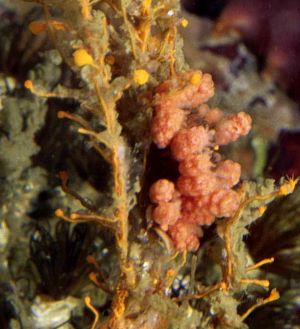
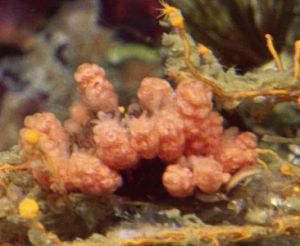
Hi Bill,
I had a little trouble with this one due to the colour, but Dave Behrens feels that it is Doto columbiana.
I found it at Ruby Rock, Port Hardy, British Columbia, Canada.
Depth: 10 metres
Length: 7mm
Photograph: Marli Wakeling
Best wishes,
Marli.
scubamarli@excite.com
Wakeling, M., 2001 (Oct 6) Doto columbiana? from British Columbia. [Message in] Sea Slug Forum. Australian Museum, Sydney. Available from http://www.seaslugforum.net/find/5365Note added 30 Jan 2006: This is Doto amyra. See message #15688.
Thanks Marli,
Before I make a page for it I would welcome some comments on its identity. It seems rather different from Doto columbiana which typically has quite a heavy marking of black on the body
Bill Rudman
